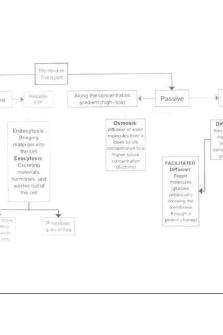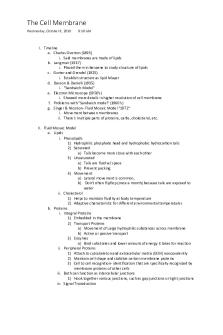9:17 Membrane Electrophysiology PDF

| Title | 9:17 Membrane Electrophysiology |
|---|---|
| Course | Evolutionary Medicine |
| Institution | University of Southern California |
| Pages | 3 |
| File Size | 264.7 KB |
| File Type | |
| Total Downloads | 1 |
| Total Views | 148 |
Summary
Medicine 100...
Description
System Name: FMS 2 – Physiology Lecture Name: Membrane Electrophysiology Lecture Date: 9/17 Exam Date: 10/30 Distinguish between net flux and unidirectional flux, voltage difference due to ion flux Electrochemical Equilibrium Most animal cells have an electrochemical potential of 40-100 millivolts across plasma membranes Usually negative potential within cell relative to extracellular fluid Net diffusion of ions from higher concentration to lower concentration proportional to concentration difference Net flux – when concentration of ions is equal on both sides, ions still move but no net movement Unidirectional flux – the movement of one ion in one direction, will happen in both directions Voltage difference – proportional to rate of ion movement between both sides o Causes a driving force for ions to move o Arise b/c ions move across membrane at different rates Driving force – force that drives ions to move due to concentration + voltage differences o Even if driving force is the same for Na+ and Cl- b/c of concentration differences, ions diffuse at different rates o Different diffusion rates b/c of the size of the hydrated ions o Hydrated chlorine smaller than hydrated sodium ∴ smaller frictional resistance moving through water Side that Cl- moves to will become electronegative, slow down Cl- movement and speed up Na+ movement. As Na+ catches up, Cl- starts to move faster until ions are balanced As this happens, voltage difference decreases in magnitude and ions move towards concentration equilibrium. o Transport proteins – also help determine rates of movement across membrane Electrochemical equilibrium - net force of ion is 0 b/c forces equal o May still have a concentration difference in the ion, but this concentration difference maintained by equal but opposite voltage difference o Just b/c forces are equal does not mean concentrations are the same o Concentrations of ions do not change Equilibrium potential difference – voltage difference that prevents a change in concentration difference for an ion across a membrane Electrochemical potential = chemical potential + electrical potential Membrane potential – differences in ion concentration across a cell membrane which cause a voltage difference o Resting membrane potential ranges from -40mV to -100mV o Weighted average of the equilibrium potentials described by the Nernst equation for each ion o Ions that move faster make a larger contribution to the membrane potential no matter the mechanism of transport o Extremely small # ion movement – causes large changes in membrane potential Describe the relationship between the Nernst Equation and the equilibrium potential Nernst Equation The equation that expresses the balance between the electrical + chemical driving forces (RT/ZF) ln (Cout/Cin) = Vin – Vout = E o 60/z log (Cout/Cin) = Vin – Vout = E Electrical potential difference (V) balanced w/ driving force due to concentration differences (C) for an ion Vout – grounded at zero potential ∴ equation yields magnitude and sign of electrical potential inside the cell required to maintain the concentration difference Deals w/ only 1 ion at a time with a valence (z) RT/F = 25mV at room temperature Equilibrium potential for an ion (Ei) = electrical energy equivalent of chemical energy stored in concentration gradient Equilibrium potential Na+ = +62mV Equilibrium potential K+ = -89mV Equilibrium potential Cl- = -81mV Understand and explain the chord conductance equation Chord Conductance Conductance (g) – rate of ion
movement across cell membranes is proportional to the membrane conductance for each ion o Determined by transport proteins embedded in cell membrane Chord conductance equation – o Denominator represents total conductance of membrane to all ions o E represents Nernst (equilibrium) potential for each ion o Value of conductance for each ion relative to total conductance of the membrane determines how much weight is given to equilibrium potential for that ion o If relative conductance of Na+ were suddenly ton increase dramatically (0.9) the membrane potential would be driven towards ENa or ECl. o Changes in ion conductance occur when ion channels open/close or when # channels in plasma membrane changes o Resting membrane potential – closely matches potassium b/c potassium conductance is higher than conductance of other ions Describe the physiological consequences at the cellular level of Na/K-ATPase transport activity Na+/K+ ATPase Transports Na+ out of cell, transports K+ out Balances passive tendency for ions to diffuse to their equilibrium concentrations Hydrolyzes ATP converts chemical energy into potential energy in the form of a sodium gradient across the plasma membrane Draw a diagram of a simple epithelium. Label the different fluid compartments on each side of the epithelium and the location of the Na/K ATPase. Distinguish between transcellular epithelial transport and paracellular epithelial transport Membrane Transport mechanisms Carrier mediated transport – mediated by membrane proteins, all important solute movement Passive biological transport – transport with concentration/voltage differences, transport glucose Primary active transport – use ATP hydrolysis directly, away from electrochemical equilibrium o Na/K ATPase Secondary active transport – sodium-solute cotransport proteins, use potential energy in gradient for transport o Symport – transport two items in same direction (sodium + glucose) o Antiport – transport two items in opposite direction (Na/K) o Couple thermodynamically unfavorable rxn with a thermodynamically favorable one Transporters – use alternate access transport, can be closed, or open only intracellularly or extracellularly o Only one gate can be open at once o GLUT transporters Ion channels – voltage or ligand gated Na/K ATPase – AKA sodium pump (electrogenic b/c maintain negative resting potential in cell) Na+ passively leaks into cells, K+ passively leaks out of cells Complete inhibition results in death Pump 3 Na+ out, 2 K+ in Stores energy from ATP hydrolysis by maintaining sodium gradient Inhibited by cardiac glycosides (digitalis/ouabain) – small clinical range b/c arrhythmias can occur o Treat congestive heart failure + some arrhythmias There are other types of ATPases Epithelia Caption: Simple epithelium w/ brush border membrane at the apical (luminal) surface which is in contact w/ interior of hollow organs (intestine/renal tubule). Serosal surface in contact w/ blood vessels. Smooth muscle layers on mucosal surface of epithelium. Individual epithelial cells connected by tight junctions that contain claudins + occludin. Different transport proteins located in apical + basolateral membranes leading to vectoral transport across epithelium
Na/K ATPase – only in basolateral membrane Transcellular pathway – across the cell o Molecule passes through apical/luminal cell membrane (external environment) or brush border/mucosal surface basal/lateral cell membranes (supported by basement membrane or in contact w/ interstitial fluid/ serosal surface) Paracellular pathway – next to cells o Molecule penetrates tight junction + diffuses through lateral intercellular space between adjacent cells o Claudins – determine which ions can move between cells by paracellular route Primary driving force for net solute absorption/secretion across epithelial barriers = active transport of Na+ by Na/K ATPase in basolateral membrane of epithelial cell Transepithelial secretion of K+ by Na/K ATP-ase o Apical transporters/channels use transmembrane gradients created by pump o Absorb Na, secrete K+ Describe the regulatory volume decrease and regulatory volume increase responses of cells when exposed to hypotonic and hypertonic solutions Coupling Solute Movement w/ Water movement Concentration of pure water = 55 molar, if solute added concentration of water decreased and solute concentration increased Water follows solute to maintain equilibrium (osmosis) o Happens very quickly ∴ water at osmotic equilibrium across most cell membranes For every mOsmoles of solute that moves across membrane, 190 mOsmoles of water must also move to maintain osmotic equilibrium 1 molar concentration of NaCl = 2 Osmolar concentration of Na+/Cl- ions b/c ions behave independently Isotonic – do not cause change in volume of cells Hypotonic – less than 290 mOsmoles/L of impermeable solutes cells swell as water enters Hypertonic – more than 290 mOsmoles/L of impermeable solutes cells shrink as water leaves Tonicity does not equal osmolarity b/c of permeable ions which only have temporary transient effects on cell volume Regulatory Volume Osmotic concentration of cells = 290mOsmols/L Steady state volume – determined only by concentration of solutes like sodium which are unable to reach equilibrium due to active transport No change in cell volume w/ NaCl b/c Na/K ATP ase prevents sodium from reaching equilibrium Urea cells shrink o Transient effect b/c permeable Regulatory volume decrease – in hypotonic solution, allow for passive diffusion of K+ and an anion o If cell swells, water removed w/ ion transport tout o If cell shrinks, water brought in w/ ions o Hypotonic - ⬆ K+/Cl- efflux from cell o Hypertonic - ⬆ Na+/Cl- influx from cell ...
Similar Free PDFs

9:17 Membrane Electrophysiology
- 3 Pages

Plasma Membrane
- 12 Pages

Cell Membrane Coloring Worksheet
- 2 Pages

6-cell membrane web quest
- 4 Pages

Textbook of Membrane Biology
- 385 Pages

Membrane Transport Flow Chart
- 1 Pages

2. Potentiels de membrane
- 10 Pages

HYALIN MEMBRANE DISEASE (HMD
- 13 Pages

The Cutaneous Membrane
- 1 Pages

La membrane plasmique
- 23 Pages

The Cell Membrane
- 2 Pages

2 - GRQ- Membrane potentials
- 3 Pages

Crossing the Plasma membrane
- 9 Pages
Popular Institutions
- Tinajero National High School - Annex
- Politeknik Caltex Riau
- Yokohama City University
- SGT University
- University of Al-Qadisiyah
- Divine Word College of Vigan
- Techniek College Rotterdam
- Universidade de Santiago
- Universiti Teknologi MARA Cawangan Johor Kampus Pasir Gudang
- Poltekkes Kemenkes Yogyakarta
- Baguio City National High School
- Colegio san marcos
- preparatoria uno
- Centro de Bachillerato Tecnológico Industrial y de Servicios No. 107
- Dalian Maritime University
- Quang Trung Secondary School
- Colegio Tecnológico en Informática
- Corporación Regional de Educación Superior
- Grupo CEDVA
- Dar Al Uloom University
- Centro de Estudios Preuniversitarios de la Universidad Nacional de Ingeniería
- 上智大学
- Aakash International School, Nuna Majara
- San Felipe Neri Catholic School
- Kang Chiao International School - New Taipei City
- Misamis Occidental National High School
- Institución Educativa Escuela Normal Juan Ladrilleros
- Kolehiyo ng Pantukan
- Batanes State College
- Instituto Continental
- Sekolah Menengah Kejuruan Kesehatan Kaltara (Tarakan)
- Colegio de La Inmaculada Concepcion - Cebu


